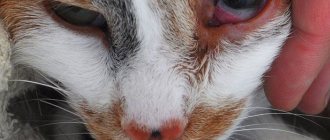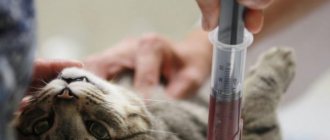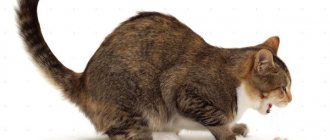Causes of black feces in cats
When the feces are black in color and the pet is feeling well, the anomaly is explained by natural causes.
The presence of additional symptoms is a cause for concern.
Physiological reasons
Blackening of cat feces is always a mistake by the owner, which can lead to dire consequences. However, one-time darkening is not a cause for concern.
The anomaly is explained by the following reasons:
- A large amount of iron enters the intestines , which interacts with food masses and forms harmless black compounds. If the animal owner notices that an abnormality has occurred after using a food supplement, it should be discontinued.
- The cat was treated to meat scraps or raw liver, which contain a lot of iron. If the diet contains a lot of raw meat, the feces will always be black, and the cat runs the risk of becoming infected with helminths.
- The animal was given a drug or food containing colored pigments , such as activated carbon. Gourmet cats have strange preferences: either give them raw potatoes, or cucumbers, or cherries. In the latter case, the feces become black.
Be sure to read:
The kitten has bad breath: reasons, what to do, when it is an alarming symptom, prevention
Although a single blackening does not cause immediate harm to health, the owner of the animal should not allow the described situations to occur again. And it’s not so much a matter of excess iron as it is a matter of protein overfeeding, a deficiency of dietary fiber and the danger of becoming infected with parasites or microbes that contaminate the meat.
Pathological causes
If the stool becomes black for a long time, this is an alarming symptom. There is only one reason: the entry of large amounts of iron into the intestines. Blood contains the most metal compounds.
Therefore, black staining of stool always indicates bleeding in the anterior intestine under the influence of the following factors:
- High worminess. Parasitic worms injure the mucous membrane of the small intestine and feed on blood. Part of the biological fluid is digested by the body's enzymes.
- Traumatic gastritis or colitis, accompanied by bleeding.
- Gastroenteritis , which occurs under the influence of pathogens of infectious diseases or toxic substances.
- A tumor process in the digestive organs, accompanied by destruction of the walls of blood vessels.
- The formation of gastric or intestinal ulcers under the influence of food or abuse of oral non-steroidal anti-inflammatory drugs.
A pathological symptom indicates the occurrence of a serious illness and the need to seek veterinary help.
Diagnosis of the condition
A pet with a characteristic symptom should be shown to a veterinarian who, after a clinical examination, will prescribe certain diagnostic methods. First of all, the doctor will conduct a detailed blood test, stool examination for helminths, protozoa, and occult blood.
An informative research method is the coprogram. Using this laboratory method, you can find out not only the microscopic composition, but also detect hidden blood in the feces of an animal. If necessary, a urine test will be performed. An ultrasound or X-ray examination of the abdominal organs, as well as a colonoscopy, can be used to find out why a cat poops blood.
We suggest you read: Sterilization of cats: at what age is it better to sterilize, is it necessary to do this, how to care for an animal after surgery and other nuances
What can black feces mean in cats?
Black feces indicate that excess iron has entered the intestines. Most often, the anomaly occurs due to bleeding in the front of the digestive tract. Even short-term blackening, if it occurs frequently, can cause chronic diseases that destroy the health of the pet.
Diets based on raw meat, as a rule, contain excess protein and lack of dietary fiber, and therefore cause chronic diseases of the digestive system.
Brown-black cat feces with an unpleasant odor
In case of ulcerative pathologies or diseases of the pancreas, the animal’s own enzymes are not active enough. A significant portion of the nutrients remains undigested. It enters the large intestine, where it becomes prey for putrefactive microbes. Feces acquire an unpleasant odor, which is characteristic of rotting meat or rancid oil.
Be sure to read:
The cat cannot pee: causes, symptoms, what to do, first aid, treatment at home
Black feces are detected and the animal does not eat anything
A very bad sign. It is characteristic of panleukopenia, a disease of young animals accompanied by severe dehydration. The animal stops eating in a pre-agonal state. Feces may darken due to either bleeding or pre-mortem changes. The pet needs urgent veterinary care.
What if your cat has black, liquid stool and vomits?
A combination of black diarrhea, vomiting, refusal to feed, and a depressed state are signs of high infestation. Before deworming, it is necessary to stop the bleeding. Parasite control must be carried out under the supervision of a veterinarian.
Even with the correct dosage, intoxication cannot be ruled out, because before death, helminths release an increased amount of toxic decay products.
During autumn deratization, many mice poisoned with anticoagulants appear. They are easy prey. The poison affects cats even more strongly than rodents. Vomiting, black feces, depression and severe dehydration appear. If immediate help is not given, the cat will die.
Bristol scale
English doctors at the Royal Hospital in Bristol have developed a simple but unique scale that characterizes all the main types of feces. Its creation was the result of the fact that experts were faced with the problem that people are reluctant to open up about this topic; embarrassment prevents them from talking in detail about their stool.
Based on the developed drawings, it became very easy to independently characterize your own bowel movements without any embarrassment or awkwardness. Currently, the Bristol Stool Shape Scale is used throughout the world to assess the functioning of the digestive system. For many, printing a table (types of feces) on the wall in your own toilet is nothing more than a way to monitor your health.
1st type. Sheep feces
It is called so because it is shaped like hard balls and resembles sheep feces. If for animals this is a normal result of intestinal function, then for humans such stool is an alarm signal. Sheep pellets are a sign of constipation and dysbacteriosis. Hard feces can cause hemorrhoids, damage to the anus, and even lead to intoxication of the body.
2nd type. Thick sausage
What does the appearance of stool indicate? This is also a sign of constipation. Only in this case are bacteria and fibers present in the mass. It takes several days to form such a sausage. Its thickness exceeds the width of the anus, so emptying is difficult and can lead to cracks and tears, hemorrhoids. It is not recommended to self-prescribe laxatives, as sudden release of feces can be very painful.
3rd type. Sausage with cracks
Very often people consider such stools to be normal, because they pass easily. But make no mistake. Hard sausage is also a sign of constipation. When defecating, you have to strain, which means there is a possibility of anal fissures. In this case, irritable bowel syndrome may be present.
4th type. Ideal chair
The diameter of the sausage or snake is 1-2 cm, the feces are smooth, soft, and easily amenable to pressure. Regular bowel movements once a day.
5th type. Soft balls
This type is even better than the previous one. A few soft pieces form and come out gently. Usually occurs with a large meal. Stool several times a day.
6th type. Unshaped chair
The feces come out in pieces, but unformed, with torn edges. It comes out easily without hurting the anus. This is not diarrhea yet, but it is already a condition close to it. The causes of this type of stool can be laxative medications, increased blood pressure, excessive consumption of spices, and mineral water.
7th type. Loose stools
Watery stools that do not include any particles. Diarrhea requiring identification of causes and treatment. This is an abnormal condition of the body that needs treatment. There can be many reasons: fungi, infections, allergies, poisoning, liver and stomach diseases, poor diet, helminths and even stress. In this case, you should not postpone your visit to the doctor.
Treatment of cats with black stools
The primary goal is to stop the bleeding.
The following drugs are used:
- Tranexam;
- Vikasol;
- Aminocaproic acid;
- Dicynone.
The next step is to eliminate the cause of the disease. If a tumor or foreign object is found in the intestine, surgery is performed.
If urgent deworming is necessary, anthelmintic drugs are prescribed.
When the infectious etiology of the disease is established, antiviral drugs, antibiotics, and immunomodulators are used.
For peptic ulcers, as well as gastroenteritis of non-contagious etiology, gastroprotectors are prescribed.
Diagnostic methods
Before prescribing diagnostic tests for a four-legged patient, the veterinarian examines him and analyzes information regarding the animal’s living conditions and nutrition, and previous diseases. Data on exactly when the pathological symptoms appeared and the nature of the clinical picture are also important. Information about the diagnostic procedures prescribed to make an accurate diagnosis is presented in the table:
| Diagnostic manipulations | Purpose of the event | |
| Laboratory research | Clinical blood test | Assessment of the condition of internal organs. |
| Blood chemistry | Liver tests to look for liver or gallbladder problems. | |
| Examination of fecal contents | Detection of remains of inflamed tissue, sand, bone fragments, toxic substances, and parasites in feces. | |
| Analysis of urine | Assessment of the general condition of the body. | |
| Instrumental studies | Ultrasound of the abdominal organs | Detection of cysts, neoplasms, fibrous tissue, obstruction of the bile ducts, sand and stones in the gallbladder. |
| Radiography | Detection of neoplasms, cysts, liver enlargements. | |
| Biopsy of affected tissue, usually the liver | Detection of a tumor. | |
When a visit to the vet should not be postponed
Urgent veterinary care is needed for your pet when the following additional symptoms occur:
- stomach ache;
- plaintive meow;
- temperature above 40 °C;
- diarrhea;
- vomit;
- refusal to eat;
- blood clots in excrement.
Be sure to read:
A cat is vomiting hair: reasons, what to do, medications and folk remedies, prevention
The most dangerous sign is the appearance of melena - feces with a tarry consistency, indicating large-scale bleeding.
Associated symptoms
If you have certain accompanying symptoms, you must consult a doctor. Delay can cost your pet serious health problems, or even life.
Symptoms that accompany the appearance of black feces in a cat may include black or red vomiting, malaise due to constant blood loss, acute abdominal pain, bleeding from the anus and nausea. These symptoms are signs of serious disorders in the body and require prompt intervention by a doctor.
A coprogram is...
Chyme, or food gruel, moves through the gastrointestinal tract and fecal masses are formed in the large intestine. At all stages, breakdown occurs, and then absorption of useful substances occurs. The composition of the stool helps determine whether there are any abnormalities in the internal organs. A scatological examination helps to identify a variety of diseases.
We suggest you read: How to treat a cat if it itches and licks
A coprogram is a chemical, macroscopic, microscopic examination, after which a detailed description of the feces is given. Coprograms can identify certain diseases. These may be disorders of the stomach, pancreas, intestines; inflammatory processes in the digestive tract, dysbiosis, malabsorption, colitis.











